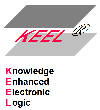
 |
Knowledge Enhanced Electronic LogicKEEL Technology Overview |
|
|
This video provides a brief introduction to KEEL Technology. |
Compsim's KEEL® (Knowledge Enhanced Electronic Logic) Technology can be used to put human-like decision-making (reasoning) in products or software applications. KEEL technology can be considered an "expert system" technology that uses the decision-making skills of a human as the basis of judgmental decisions. The KEEL Toolkit provides the mechanism to collect and test those reasoning skills before deployment in the final product.
Using the KEEL toolkit, a human (i.e., a "Domain Expert") can document how to analyze problems and take actions. The resulting code can be embedded into a device, a software application or demonstrated on the web. Special characteristics include:
The KEEL Toolkit allows a human (i.e., a "Domain Expert) to interactively model a decision-making process. The designer gets immediate feedback from the design, as the thinking process operates while the design is being created.
A variety of tools assist the designer in documenting the model. When the design is ready to be integrated into the final product, it is translated from the graphical model to conventional code (C, C++, Microsoft C++ .NET, Microsoft C#, Adobe/Macromedia's FLASH ActionScript 3, JAVA, JavaScript, Objective-C (Apple), Octave(MATLAB), Python, PLC Structured Text, Scilab (open source math tools), Microsoft Visual Basic Version 5/6, Microsoft Visual Basic .NET, VB.NET Silverlight Class, VBScript, and others including packaging for .ASPX and WCF web services) that can be provided to the software engineer for system integration. The isolation of the decision-making model from the native source code simplifies maintenance. If a logging function is integrated into the application (according to the KEEL XML schema), any decision that is logged can be read back into the development environment so decisions or actions can be reverse-engineered.
KEEL technology attempts to mimic the way that humans balance input information to make decisions. In this manner, a KEEL engine operates like an analog computer. It accumulates supporting information and balances this with objecting or blocking information. Individual considerations interact with other decisions or actions in a web of relationships that are balanced to achieve the best overall set of actions for the system. In a KEEL system, the importance of information is likely to be constantly changing. The importance of information can be controlled from external events or can be controlled as part of an internal process.
The output from a KEEL engine can be binary (YES/NO or ON/OFF), or it can be relative (do x amount of action 1 and y amount of action 2…). Events can be triggered. The number of inputs and outputs from a KEEL engine are limited only by the resources available.
The output of the KEEL Toolkit is two or three small subroutines and a series of tables that define values and relationships between information. There is no textual processing in the KEEL engine itself, only an evaluation of information. Any display and control functions are defined external to the KEEL engine.
Unlike neural nets and fuzzy logic, the KEEL logic can be easily visualized and explained. The use of a pattern matching approach to cognitive solutions could present a problem when it is important to validate the decisions or actions. With pattern matching there is no "reasoning" taking place other than to suggest that there is some degree of a matched pattern. When patterns are similar, but not the same, there is a risk that the wrong choice is made purely because the patterns are somewhat similar. A mechanism that uses an organized process is more likely to give a correct response. KEEL technology provides such a process.
KEEL Frequently Asked Questions
KEEL Evaluation Review Questions